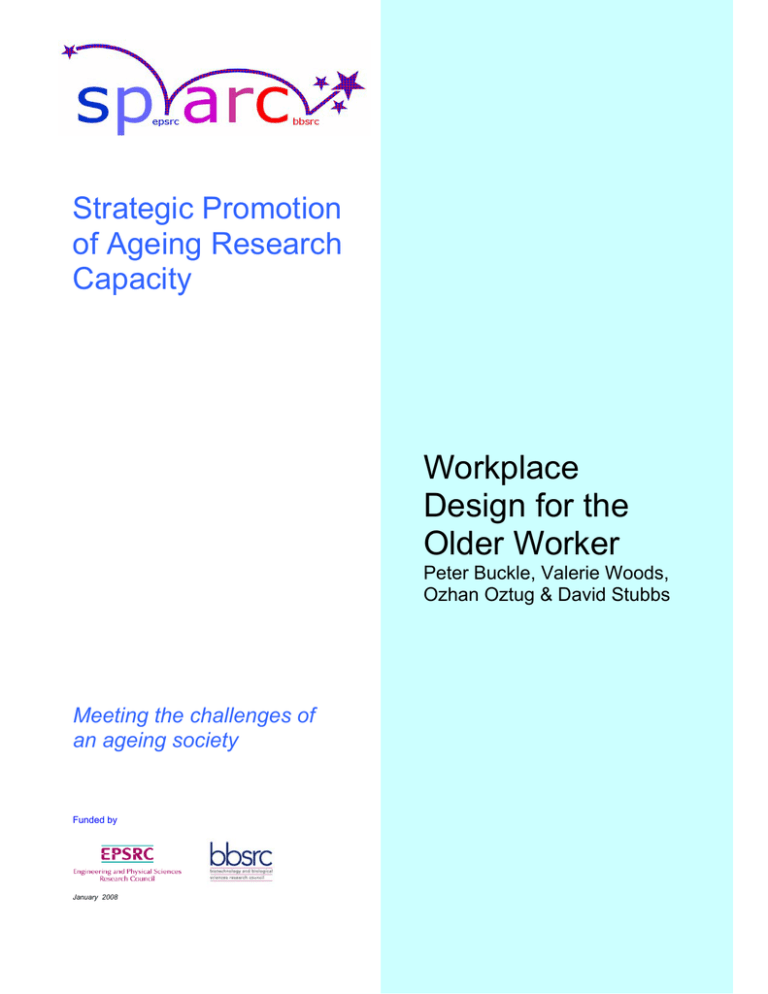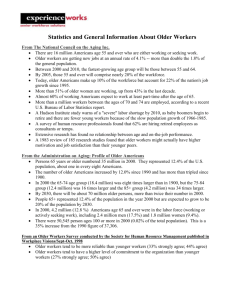Workplace Design for the Older Worker - SPARC
advertisement

Strategic Promotion of Ageing Research Capacity Workplace Design for the Older Worker Peter Buckle, Valerie Woods, Ozhan Oztug & David Stubbs Meeting the challenges of an ageing society Funded by January 2008 Workplace Design for the Older Worker Professor Peter Buckle, Dr Valerie Woods, Dr Ozhan Oztug & Professor David Stubbs University of Surrey A qualitative study of older workers has identified important themes and generated a new model of factors important to the ageing workforce. The motivation of older workers to continue to work could be greatly improved if more attention was paid to both their physical working environments and the way in which they are managed. In general, older workers are positive about work, and realistic about their capabilities and aspirations. Some individuals are keen to continue working for social, as well as financial, reasons. Work-related health problems, coupled with a declining recognition of experience by both management and younger workers, combine to de-motivate older workers. There are many small steps which could be taken to redesign equipment and train workers in its use in order to reduce the physical consequences of manual work. Scheduling work in a way which respects the capabilities of the older worker may become more important as the workforce ages, rather than depending on informal organisation methods which rely on younger workers helping older workers with more demanding tasks. Managers should map existing practice to the new model, and identify and resolve areas of difference if they wish to maintain and motivate the older workforce. Key Findings • • Older workers recognise and, for the most part, accept their changing relationship with the world of work. However, they are not satisfied with the ways in which their experience and commitment is recognised, or by the support which they receive from management. Whilst they accept that their physical abilities, to some extent their cognitive skills, and in some cases patience, have declined, these are compensated by knowledge and experience accumulated over a life-time of work. There are many reasons for older workers to continue working. A main reason is financial, but it is also recognised that work provides a structure to life and important social networks. Reasons given for wanting to stop working include the negative attitudes of management, difficulties of communicating with senior management, and health-related issues. Long-term exposure to hazards such as heavy physical work, shift work, heat, dust and noise are cited as health-related issues. Regular health checks, provided by some firms, were viewed positively. • • Older workers becoming reliant on younger workers to undertake more physically demanding tasks, were reported. This has led to a culture where younger workers believe they ‘carry’ older workers who earn more than they do, and older workers believe that younger workers are unreliable and less skilled. With increasing numbers of older workers in society, this may be an important issue for work-planning and allocation, especially as there is the potential for serious intergenerational conflicts in the workplace. To some extent these problems can be overcome by better equipment, designed to reduce the physical demands for those who undertake heavy manual tasks and enhanced workplace design could support those in office based roles. This would enable older workers to undertake a fuller range of tasks and help to ensure that younger workers are not subject to the work-induced health-related disorders which have affected today’s older workers. New approaches to the allocation of work, especially the scheduling of shift work would benefit all workers, not just older workers. Introduction The Issues Few workplaces or organisations have been designed with the needs of the older worker in mind. Despite the ‘Inclusive Design’ research agenda, there is little knowledge of what the workforce sector requires, and there is little known about what help organisations will need in order to accommodate older workers. The Aims of the Study This study identified and investigated organisational issues which older workers believe need to be addressed in order to achieve a healthy working environment that meets their abilities, capabilities and experience. The study considered: • The Background The population in the UK is ageing, with the proportion and numbers of older people in society increasing. In 1951, there were 13.8 million people aged 50 and over in the UK; by 2001 this had increased to 20 million. By 2031, forecasts suggest that there will be 27.2 million people aged 50 and over in the UK. The rising number of older people has led to an increased interest in the role of older people in work, and on well-being in later life. Work is a key concern for people in their fifties and sixties. Many face difficult decisions about when to retire, and in some cases are forced to do so. In many cases though, they wish to continue working, and financial considerations (e.g. pension plan shortfalls) may make this option a necessity. The Government has an ambition to achieve an employment rate of 80% within a generation. This compares with the current rate of 75% today. A major part of the increase will come from higher participation rates by workers over 50. The Government has pledged to encourage and help older people to work, setting out its goals in a Public Service Agreement to 'Tackle poverty and promote greater independence and wellbeing in later life' as part of the 2007 PreBudget report and Comprehensive Spending Review. • • • • the strengths and weaknesses in the suitability of current workplace design for older workers; organisational issues (for example, adjustments/procedures/policies and support networks) that need to be addressed; understanding individuals’ experience, behaviour and interaction, and their social contexts; areas for further research, and technical developments that might overcome current barriers; examples of good practice that might form the basis for more extensive adoption. The Study The study involved four organisations based in food manufacturing, supermarket retail, social care and the cleaning industry. They were located in the North East, West Midlands and South Central England, and in Wales. Focus groups were formed with a total of over 60 workers from age groups of 40-49, 50-59, 60+ years and a sample of recently retired workers. They were mainly from the ‘shop floor’ but a number of office workers also took part. In addition, occupational health professionals and representatives of the human resource management teams were interviewed. Confidentiality was assured throughout the study. All the interviews were transcribed verbatim then analysed using a qualitative data analysis programme. ‘Older workers’ refers to participants who were aged 50 years and above and ‘younger workers’ to those aged 40-49 years. Further, although both male and female workers took part in the focus groups all participants are referred to as male in the following summary to preserve anonymity. Findings Perceptions of Organisational Culture The issues raised in the interviews fell into five main categories. This category relates to the factors that were perceived by participants to be important with respect to their age and the organisations’ culture. As they aged, some participants reported that their career opportunities became limited and that their accumulated knowledge was superseded: “It’s almost like we get to the burn-out stage and then we are put out to grass.” There was a consensus that limited career opportunities affected motivation for personal development. However, it appeared that some individuals were happy with their existing knowledge, which they had accumulated over long years of service, and did not wish for further development. One of the participants expressed his resistance for personal development: “If I’d wanted to, I think I should be able to be given the opportunity of doing something, but I feel that it’s not there. They may contradict me and say ‘Yes, it is.’ But it’s not that apparent. It’s definitely not apparent to me, but as I say my choice is that I wouldn’t want to at this stage.” Similar concerns were raised by the younger workers. They believed that as workers aged, they were likely to be perceived as less adaptable in dynamic work settings in comparison with younger workers. One of the workers stated: “I think part of people’s perception is, as you’re getting older they can’t think of you in the same way as the younger person coming into the business and that you’re not as flexible.” Motivations to Leave or Continue Working The participants expressed a range of factors as motivators for either continuing or leaving their jobs. “Finance” was the most frequently reported motivator for older workers to continue working. Overall, both younger and older workers reported that they were quite satisfied with their earnings. One financial reason mentioned by an older worker for continuing to work was better investment in pension plans: “As I said, 18 years ago, I took out an investment plan. If you remember, 18 years ago insurance companies weren’t allowed to give you advice like they do nowadays. If hindsight had prevailed, I could have been retired now, but my investment plan takes me until I’m 65.” Similar views were expressed by a younger worker: “I said 60 [previously thought age for retirement] but you just don’t know, do you? You’re on a pension, you see the changes being made now, we could be here until we’re 65 because monetary-wise you could be worse off if you don’t. You just don’t know.” Some of the older participants reported social reasons for continuing to work. One of them thought that coming to work provided a structure to his life. Another reported that he was enjoying coming to work as he had good social networks there: “It’s the discipline isn’t it really? Getting up every day, knowing that you’ve got to do certain things…” The participants also expressed some factors as motivators to leave the job. One of the older participants said having regular sleep was a motivator to leave the job: “But what I have also noticed as well, is that on some occasions, some of the blokes that you see now, that you haven’t seen for two or three years, they look younger now than when they worked here… They’re getting sleep; they’re getting regular sleep …” Another older worker thought that the attitudes of the management had changed, and that it was more difficult to communicate problems to the senior management. He expressed this as a motivator for leaving the job earlier than the normal retirement age of 65: “I must admit, if you’d have asked me 10 years ago whether I wanted to retire, I’d have said no. I’d have been quite happy working as long as I could, but it’s the atmosphere, I think, in the factory that’s changed. I wouldn’t want to stay on.” Some of the younger workers expressed health status as a reason for possible early retirement. One of them thought that working for long years might lead to ill-health that might result in premature death: “My dad took early retirement when he was 59 and he always said to me he’d lost a lot of money with his AVCs and different things, but he wanted to be at home with my mum. Good job because he died when he was 67. If he’d have stopped when he was 65 he’d have only had two years…” There was a consensus amongst workers that shift-work patterns were difficult to follow: “That is what I find difficult as I’ve got older, the pressure of the work and the physical hours of the shift work.” One of the younger workers suggested that shift-work was a source of stress as it made working conditions difficult, and was one of the reasons people were choosing either to retire early or changing to less stressful jobs: “But you look at the people that have actually retired from XXXXXX, that took early retirement from XXXXXX and got other jobs and are enjoying themselves because they’ve got different jobs without any stress-related to them….People have gone. They want to get away from this after they’ve been in it for such a long time.” Health Issues Regular health checks, provided by some firms, were viewed positively by the older workers. One of them described this as being “cared for”. There was a consensus that Occupational Health Departments were looking after older workers well: “Certainly the Health & Safety departments look after the older worker. They monitor our health, I think more frequently than others...” “As I said, the only positive I see [about getting older in this organisation] is the occupational health, as far as the fitness thing goes, and the physio. “ One of the participants, on the other hand, raised a concern regarding the environmental conditions, and believed that older workers might become more sensitive to environmental exposures such as heat, dust and noise: “The working environment at the factory as a whole is quite good. I mean, it can get terrible out on the Process. - What do you mean by ‘terrible’? Dust, noise, heat. - Do you think those issues are worse as you get older? Oh yes…Oh yes. I certainly find now that things like that would aggravate me far more now than they would have done. It can make you feel unwell. I mean, you can probably hear that I’ve got a problem with my throat anyway, which the dust aggravates. It does aggravate it. I should wear a dust mask, but unfortunately with that, these hair nets, you feel as though you’re in a helmet and it’s hot out there. It’s dirty, it’s wet.” Perceptions of Own Capacity Two issues emerged about perceptions of older workers’ own capacity. These were cognitive ability and patience. Some workers thought that as they aged, their cognitive ability to learn and recall information was declining. One of them expressed this as follows: “The other thing I find wrong is that as you get older, although you might get there eventually, it takes a bit longer to take things in. You can’t be as quick. Twenty years ago I was quite sharp in the brain and now it takes a bit longer.” Another older worker suggested that as he was getting older he perceived himself as becoming less patient: “I just find that at my age now, whoever said ‘With age you get patience’ is a liar. You don’t get patient. You get less patient.” “People go to your desk and they say ‘There’s a bolt loose’ and you want to really scream at them ‘Well tighten it.’ …You don’t get more patient, you get more impatient.” In contrast one of the younger workers thought that as individuals grow older they become more mature in their views: “I don’t know. I think you get a more rounded view on things, don’t you? I think when you’re young you tend to just hone in on specifics and treat them as the centre of the earth at that particular time.” Coping with Job Demands The interviews revealed that there may be some sort of reliance amongst some of the older workers, on their younger colleagues for some tasks. A number of the older workers said they found the physical aspect of their jobs difficult to carry out and sometimes they asked for help from their younger colleagues: “It’s very difficult on the process because the lines that we run … you’ve got to do every job on that line …It just doesn’t work any other way. I’m lucky that the two people I work with will take a fair bit off my shoulders on the heavy stuff. - Are they a similar age? No. They’re in their 40s. They’ve both got health problems – back, legs, knees – that sort of thing, but with their age they’re able to take some of the weight a bit from me, which I’m very grateful for, but it puts more work onto them.” A number of the younger workers confirmed that they sometimes helped their older colleagues in carrying out physically demanding tasks. One of them expressed this as ‘carrying older people’: “- You definitely feel that you’re carrying the older people? Yes, not with the technical bit. The fellow I work with, he’s as technically advanced as anyone and he’s 62, but the physical nature of it, there comes to a point where people find it more difficult to do the job that we’re doing. - You said about workload sharing. Do you have an example like that? No, just job-share. Like we say, we carry the older people and it happens a lot on the night work.” Themes Perceptions of self and colleagues Motivations to leave/stay Others' perception of older workers Structure to life and being active Opportunity to work longer Experienced More able bodied Financial reasons Encouragement to progress Dedicated and reliable Less committed to their jobs Perceived health risks and health status Capacity matched workload Vulnerable to medical conditions Lesser quality of work Suitability of shift patterns Appreciation of knowledge and experience Being carried by younger workers Get tired quicker Enjoying the job Flexible shift patterns Privileged at work Weaker and vulnerable to MSDs Accompanying retired partner/ family member Consulting Self Reduced Capacity Physical abilities Slower Declining cognitive abilities Younger colleagues Future expectations Job alternatives with less stress Personal attributes Committed to job Managerial attitude Advice received Not career oriented Mature Figure 1: Themes that emerged from the study, which have implications for organisations, managers and members of the workforce. Discussion and Implications Themes Important themes emerged from the study, which have implications for organisations, managers and members of the workforce. These have been detailed in a model (see figure 1). Motivations to Stay or Leave Motives to stay in a job include the structure to life given by work, the need to remain active, and the need for financial income. Job satisfaction and enjoyment were reported by many as motivators to stay, although looking for alternative employment in jobs with less stress emerged as a motive to leave. Importantly, management attitudes to older workers influences motivation and this, coupled with communication issues, may be important to consider by those organisations wishing to recruit or retain the experienced members of the older workforce. Perception of Self Older workers were aware of changes in their physical and cognitive capacity, and felt that provision should be made for this. This would suggest that current knowledge from laboratory based findings on age-related changes probably do have relevance to the real world of work, and the implications of this need to be recognised by equipment and workplace designers. Examples of physical issues were particularly evident in the social care and cleaning sectors. In the former, provision of equipment to reduce manual handling loads is important. Training was seen as being most effective by the older workers when undertaken in the appropriate setting, for example in the context in which it is to be used. In the cleaning sector, the recent introduction and use of lightweight plastic vacuum cleaners and improved cleaning agents have made a substantial difference to older cleaners, including lowering the risk of developing musculoskeletal disorders. As these disorders are highly prevalent, the importance of these simple physical design changes should be recognised. Others’ Perceptions of Older Workers Younger workers saw older workers as privileged and often felt that they were carrying older workers, particularly in the social care and manufacturing sectors. They felt that older workers earned more money for the same amount of work. In contrast, older workers frequently thought that younger workers did not do a very good job and were less reliable. With increasing numbers and proportions of older workers in the work-force, this may be an important issue for work-planning and allocation, especially as there is the potential for serious intergenerational conflicts in the workplace. Human Resources and Occupational Health Managers generally viewed older workers as reliable, but as more vulnerable to medical conditions and were off-work for longer periods when sick, compared to younger workers. Managers should consider how well their existing policies and practices map onto the model generated in this study. They may find it helpful to identify areas where current practice does not address the issues raised by the older members of the workforce. These issues may then require further attention. Future Expectations The need for better communication and consultation was a major topic that must be addressed if the ageing workforce is to be appropriately managed. Older workers want managers to support and value them, and to listen to their ideas. When there are changes to be made to the work system, they want to be consulted. They want their knowledge and experience to be recognised and to receive encouragement for their continuing development. In the social care sector, the importance of interactions between individuals was frequently raised. There was a desire for a more flexible system with fewer clients for the older workforce, and for consultation with older workers at an individual level to ensure appropriate capacity matching. This may require the better provision and modification of equipment. Shift work will also need further study, as many older workers want suitable shift patterns with respect to their home life. For example, grandparents would like shift patterns that give them time to spend with their grandchildren. The Research Team Professor Peter Buckle, Director, Robens Centre for Public Health Ergonomics, University of Surrey, Guildford GU2 7TE p.buckle@surrey.ac.uk Dr Valerie Woods Lecturer Dr Ozhan Oztug Lecturer Professor Dave Stubbs Professor of Ergonomics The Study The study received financial support from SPARC of £36,357 and ran for 12 months ending in November 2007. Additional support was provided by the University of Surrey. More information about the study can be found on the SPARC website www.sparc.ac.uk and obtained directly from the investigators. Bibliography and Key References Buckle P., Woods V., Oztug O., Stubbs D. 2008. Understanding workplace design for older workers: a case study. Contemporary Ergonomics. Taylor and Francis. (In press) Huppert F. 2003. Designing for older users. In: Clarkson J., Coleman R., Keates S., Lebbon C. (Eds) Inclusive Design: Design for the Whole Population. London: Springer Verlag. Richards T., Richards L. 1991. The NUDIST System. Qualitative Sociology. 14:289-306. Taylor-Powell E., Renner M. 2003. Analyzing qualitative data. University of Wisconsin, Cooperative Extension. http://learningstore.uwex.edu/pdf/G3658-12.PDF Woods V., Buckle P. 2002. Work, Inequality and Musculoskeletal Health. Norwich: HSE Books, CRR 421/2002. ISBN 0 7176 2312 2. Acknowledgements The research team would like to express their thanks to the organisations and participants who gave their time and their valuable resources to enable this study to take place. Disclaimer Except as permitted for academic, personal or other noncommercial purposes, users must not reprint or electronically reproduce this document in whole or in part without the prior written permission of the principal investigator, or in accordance with the Copyright, Designs and Patents Act 1988. This document has been produced from unpublished data that has not been peer-reviewed. The research was funded by EPSRC and BBSRC but they are not responsible for the content of this document. SPARC SPARC is a unique initiative supported by EPSRC and BBSRC to encourage the greater involvement of researchers in the many issues faced by an ageing population and encountered by older people in their daily lives. SPARC is directed, managed and informed by the broader community of researchers, practitioners, policy makers and older people for the ultimate benefit of older people, their carers and those who provide services to older people. SPARC pursues three main activities: Workshops to bring together all stakeholders interested in improving the quality of life and independence of older people. Advocacy of the challenges faced by older people and an ageing population and of the contribution of research to improving quality of life. SPARC is inclusive and warmly welcomes the involvement of everyone with a relevant interest. Small Awards to newcomers to ageing research, across all areas of design, engineering and biology and at the interfaces relevant to an ageing population and older people. In 2005 and 2006 SPARC received 185 applications for support in response to two invitations for competitive proposals of which 34 were supported. Executive Summaries SPARC is supporting its award holders through funding, mentoring, a prestigious dissemination platform, professional editorial assistance, international activities and provision of contacts. Each of the projects has been small, yet the enthusiasm for discovery, and impatience to contribute to better quality of life for older people, has more than compensated for the very limited funding which was provided. This executive summary is one of a series highlighting the main findings from a SPARC project. It is designed to stand-alone, although taken with summaries of other projects it contributes to a formidable combination of new knowledge and commitment by newcomers to ageing research, with a view to improve the lives of older people. This is a tangible contribution towards ensuring that older people receive full benefit from the best that research, science and technology can offer.



